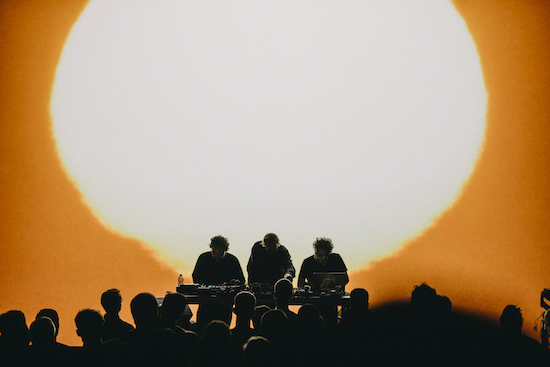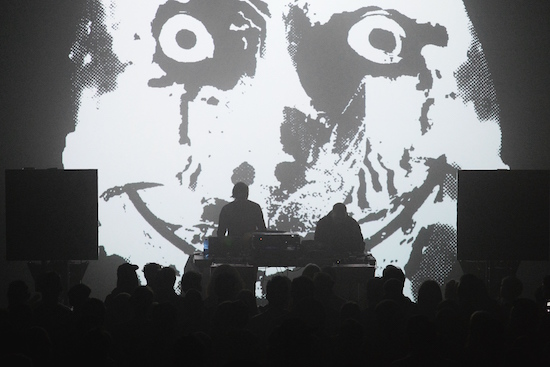Amnesia Scanner photo by Richard Hodonicky
At Lunchmeat, the art is as important as the music. Most of the lineup is AV collabs between musicians and visual artists, and it gives most of the shows the sense that something truly unique is happening – which is kinda what it’s all about after all, right?
Prague’s recent position as one of the dozen or so European cities you’ll occasionally hear pegged as the “next Berlin” feels increasingly apt. (Though the concept in general is admittedly a dumb one. For one thing, the drop in beer quality Prague would have to undergo to qualify would be unthinkable). The city’s seventh district, dubbed simply Prague 7, seems to be the centre of the city’s hipdom, awash with cultural institutions, galleries, nice-looking cafes and bars, plus beardy dudes in John Lennon glasses. It’s also where Lunchmeat Festival has been taking place the past couple of years, in the subterranean section of the National Gallery’s massive Exhibition Palace. It’s a venue well-suited to their needs: there’s a large stoney amphitheatre and a smaller clubbier space, with plenty of ass-shaking room and dark corners to lumber into between sets. Most importantly, you’ve always a good view of the screens and projections.
Early on Friday evening, two artists from the local Genot Centre label (oft featured in tQ’s tape reviews column) ease us into a heavy night. Enchanted Lands (aka Barbora Polcerová) crafts slowly shifting soundscapes on her laptop, sweeping collaged elements across the stereo field and segueing between chapters with dreamy looseness. Wim Dehaen on visuals walks us through a CGI landscape of rolling hills and lakes, plunging us into water, grass and sky. It’s a relatively simple take on the AV concept, but the two elements interact with and complement each other beautifully.

Demdike Stare
The big hitters at the festival are Amnesia Scanner, Actress and Lee Gamble, plus a nice big DJ set from Regis. Although their visuals have the whiff of an almost Banksy-esque faux-wokeness, Amnesia Scanner do well to billow impressive plumes of the smoke over the best-attended gig of the festival. The duo play stuff both off and on their recent debut album Another Life, but the central conceit is that we’re watching an overdriven hyper-heavy dancehall show from another planet. It’s definitely experimental with a small ‘e’, even skirting some mainstream EDM territory, but the set’s also home to some of the most fun to be had at the festival. We all dance, our eyes full of flashing lights and projected agitprop and dizzying smoke. Lee Gamble’s show is similarly reliable, pouring bass and beats out the speakers to copious hyper-colourful Gamble-branded projections.
Many of the best moments of the festival, though, are below the proverbial fold in the lineup. Irish producer Eomac (half of Dublin duo Lakker) is a high point, careening through intensely physical and complex breakneck beats while his collaborator Sal similarly cuts and chops and screws footage of a nude dancer losing his shit (not literally) to the music. Surprisingly, Demdike Stare’s collaboration with visual artist Michael England is above all massively beautiful. The Manchester duo thrive in darkness, but Michael England’s cinematography, shot around NYC, brims with colour and light. Much of the time he focuses on the faces of New Yorkers; the breadth of vivid emotion in these faces – telling entire stories with mere looks – imbues the set with emotive drama. Wobbles of bass and beat-y crescendos from Demdike Stare clash with the imagery and bring a nuanced emotional effect. So many electronic musicians currently aim to address these “tough times we’re living through” (or something to that effect) but this set is one of the best examples I’ve experienced. DDS and England somehow portray the truth of a digital society in ideological chaos: unshowable trauma brimming beneath the surface of faces projected 20ft high.
Kiwi producer FIS collaborated directly with the festival in preparation for his performance, which culminates in an especially amped-up version of his heavy abstraction. Gaping moments of dramatic loud and quiet are punctuated by rays of light sweeping through the space. More than just a concept or experiment with the festival format, Lunchmeat feels like the beginning of a new approach to electronic music performance at large; reality augmented.


